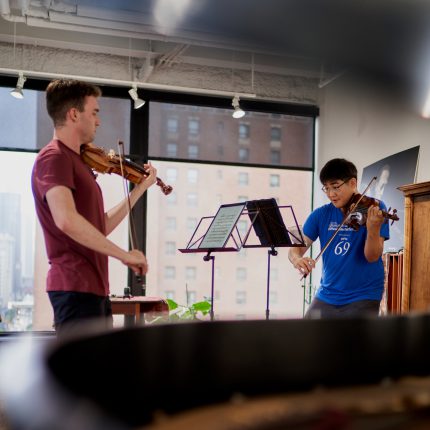Nexus Chamber Music nestles into tight quarters with an avian program

Guarneri Hall is a curiosity of a venue. The small space on the third floor of a nondescript Loop office building only seats about 60 people — uncomfortably — yet is possessed of exquisite acoustics. The space was designed for recording purposes and live-streaming concerts, and for these it would seem ideal, while the in-person experience makes for a singular combination of claustrophobia and sonic splendor.
The acoustics are such that at soft dynamics you can hear a violinist’s fingers as they land on his fingerboard, and the sound of dampers settling back onto keyboard strings when a pianist releases the pedal. These detail-amplifying features would make Guarneri Hall an unfortunate choice for less-than-polished performers, but such was not the case Wednesday night when Nexus Chamber Music opened their second annual weeklong festival at the new downtown venue.
The opening program was dubbed “Call of the Birds,” as several works on offer were inspired by birdcalls. The concert began with Haydn’s String Quartet in C Major, Op. 33 No. 3 (“The Bird”) in an elegant reading for a quartet of rising string virtuosi including Nexus co-artistic director Alexander Hersh on cello. The players were in sync with the composer’s assorted avian inspirations, with first violinist Alexi Kenney’s silvery tone highlighting the ensemble, rounded out by violinist Gabriela Lara and violist Zoë Martin-Doike.
Incorrectly listed in the program as A Bird Came Down Walking,Toru Takemitsu’s late work A Bird Came Down the Walk for Viola and Piano followed, receiving an elevated reading from Martin-Doike and pianist Victor Asuncion. Martin-Doike fully inhabited the Japanese composer’s nervy late idiom, lending her sonorous tone to the work’s static textures and reflective modal wandering. Asuncion was a sensitive support here as throughout the evening.
Hersh followed Martin-Doike in the spotlight for Fauré’s Romance for Cello and Piano, Op. 69. The young cellist is a consummate instrumentalist, but his agitated demeanor on stage distracts from his musicianship. Noisily audible breathing from him and a repertoire of facial expressions worthy of the late Robin Williams detracted from his ardent rendition of this incidental work. Given that it bore no connection to the packed program’s feathered theme, this item might have been omitted without loss.
This would have been particularly wise given the work that followed: Messiaen’s Theme and Variations for Violin and Piano, played by Kenney and Asuncion. Forgoing the Fauré and following Takemitsu with Messiaen could have underscored the immense influence the devoutly Catholic French modernist had on his Asian colleague. (Upon learning of Messiaen’s death in 1992, four years before his own, Takemitsu lamented, “His death leaves a crisis in contemporary music!”) A prominent aspect of the composers’ cross-pollination was their utilization of birdsong, the supposed thematic crux of the evening (which also could have benefitted from program notes of any description).
That missed programming opportunity notwithstanding, Kenney offered a commanding performance of this searing work. Even in the cramped quarters, the loudest dynamics always sounded robust rather than deafening, with Kenney vehemently projecting the affective core of Messiaen’s opus, and Asuncion an entirely simpatico partner.
The concert closed with Schumann’s well-worn Piano Quartet in E-flat Major, Op. 44. As with the Fauré, the connection with birds was unclear, except for a passing comment from violinist and co-artistic director Brian Hong that the work “soars,” which felt like a stretch.
With Hong replacing Kenney in the violin spot, Schumann’s familiar work sounded fresh in the hands of the young Nexus musicians. The opening Allegro brilliante was expansive with unrepressed élan, with only some fitful insecurity in the piano as a debit, and the players captured the desolate mood of the ensuing “In modo d’una marcia.” The Scherzo perhaps went best, with its propulsive rising gestures fleet and mirthful, and the closing Allegro punctuated the evening with energy to spare.
Nexus Chamber Music continues its residency at Guarneri Hall, 6:30 p.m. Friday with Dvorak’s Miniatures for Two Violins and Viola, Kurtág’s Signs, Games, and Messages, Prokofiev’s Sonata for Two Violins in C Major, and Brahms’ Piano Quartet No. 1 in G Minor. https://guarnerihall.org/
Posted in Performances




